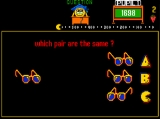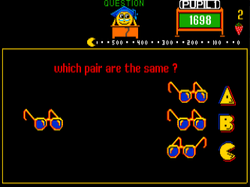
Professor Pac-Man
Encyclopedia
Professor Pac-Man is an arcade game
produced by Bally Midway
in 1983.
character though, Professor Pac-Man flopped due to a slow pace and an abandonment of the famous maze
game.
 The game is for one player or two (taking turns) and consists of answering multiple-choice questions before time runs out. The timer is a Pac-Man eating a row of dots; The more dots left when a correct answer is given, the higher the score awarded. As the levels progress, the dots disappear more quickly. Bonus questions are given after several correct answers. The game ends when a certain number of questions are answered wrong, or when time runs out.
The game is for one player or two (taking turns) and consists of answering multiple-choice questions before time runs out. The timer is a Pac-Man eating a row of dots; The more dots left when a correct answer is given, the higher the score awarded. As the levels progress, the dots disappear more quickly. Bonus questions are given after several correct answers. The game ends when a certain number of questions are answered wrong, or when time runs out.
Midway originally had plans for three different versions of this game:
There were to be new question upgrades every four months to keep people from memorizing the questions.
The game never caught on. Only 400 units were made, all of the Public variety; almost 300 of these were returned to the manufacturer and converted to Pac-Land
machines. It is estimated that only a very small number of Professor Pac-Man machines still survive.
Professor Pac-Man was based on a Zilog Z80
microprocessor and used two banks of 512k ROM
, more than any other arcade game at the time. The program logic was written in the FORTH computer language. The game was written by Rick Frankel, graphics were created by Mark Steven Pierce and Sue Forner and the sounds and music by Marc Canter
. Marc Canter and Mark Steven Pierce (along with Jay Fenton
) would later start the company MacroMind
, which would eventually become Macromedia
.
A Professor Pac-Man character appears in the Pac-Man World series. He looks similar to the character depicted in the Professor Pac-Man arcade game, except with an addition of a white mustache and a design closer to the official Pac-Man design. Other than that, there are no connections to the Arcade game, as they are created by two separate companies — the Pac-Man World character was created by Namco
, which developed the first Pac-Man game and most subsequent games in the series.
Arcade game
An arcade game is a coin-operated entertainment machine, usually installed in public businesses such as restaurants, bars, and amusement arcades. Most arcade games are video games, pinball machines, electro-mechanical games, redemption games, and merchandisers...
produced by Bally Midway
Midway Games
Midway Games, Inc. is an American company that was formerly a major video game publisher. Following a bankruptcy filing in 2009, it is no longer active and is in the process of liquidating all of its assets. Midway's titles included Mortal Kombat, Ms.Pac-Man, Spy Hunter, Tron, Rampage, the...
in 1983.
Description
Designed to capitalize on the perceived quiz game niche, the game presents simple visual puzzles and requires the player to solve each within a short time limit. Despite the game's use of the popular Pac-ManPac-Man
is an arcade game developed by Namco and licensed for distribution in the United States by Midway, first released in Japan on May 22, 1980. Immensely popular from its original release to the present day, Pac-Man is considered one of the classics of the medium, virtually synonymous with video games,...
character though, Professor Pac-Man flopped due to a slow pace and an abandonment of the famous maze
Maze
A maze is a tour puzzle in the form of a complex branching passage through which the solver must find a route. In everyday speech, both maze and labyrinth denote a complex and confusing series of pathways, but technically the maze is distinguished from the labyrinth, as the labyrinth has a single...
game.
Gameplay

Midway originally had plans for three different versions of this game:
- Family, appropriate for all ages but geared toward younger players.
- Public, appropriate for general audiences but geared toward arcades and bars.
- Prize, for casinos.
There were to be new question upgrades every four months to keep people from memorizing the questions.
The game never caught on. Only 400 units were made, all of the Public variety; almost 300 of these were returned to the manufacturer and converted to Pac-Land
Pac-Land
is an entry in the Pac-Man series of arcade video games, released into arcades by Namco, and its American distributor Bally Midway , in 1984. It was the first Namco arcade game to use the then-new arcade system later titled as Namco Pac-Land...
machines. It is estimated that only a very small number of Professor Pac-Man machines still survive.
Professor Pac-Man was based on a Zilog Z80
Zilog Z80
The Zilog Z80 is an 8-bit microprocessor designed by Zilog and sold from July 1976 onwards. It was widely used both in desktop and embedded computer designs as well as for military purposes...
microprocessor and used two banks of 512k ROM
Read-only memory
Read-only memory is a class of storage medium used in computers and other electronic devices. Data stored in ROM cannot be modified, or can be modified only slowly or with difficulty, so it is mainly used to distribute firmware .In its strictest sense, ROM refers only...
, more than any other arcade game at the time. The program logic was written in the FORTH computer language. The game was written by Rick Frankel, graphics were created by Mark Steven Pierce and Sue Forner and the sounds and music by Marc Canter
Marc Canter
Marc Canter is CEO of Broadband Mechanics, which produces People Aggregator, a social networking tool with source available . Previously, he was a founder of the company that became Macromedia. His blog, Marc's Voice, frequently critiques other Internet luminaries and competitors, such as Mark...
. Marc Canter and Mark Steven Pierce (along with Jay Fenton
Jamie Fenton
Jamie Faye Fenton is a game programmer. She is known for being the programmer of the 1981 hit arcade game, Gorf, before she transitioned from male to female around 1998. The community of transgendered people is a place where Jamie has been active...
) would later start the company MacroMind
MacroMind
MacroMind was an Apple Macintosh software company founded in Chicago in 1984 by Marc Canter, Jay Fenton and Mark Stephen Pierce. The company's first product was SoundVision, a combined music and graphics editor. Before the release, the graphics editor was removed, and SoundVision became MusicWorks...
, which would eventually become Macromedia
Macromedia
Macromedia was an American graphics and web development software company headquartered in San Francisco, California that produced such products as Flash and Dreamweaver. Its rival, Adobe Systems, acquired Macromedia on December 3, 2005 and controls the line of Macromedia...
.
A Professor Pac-Man character appears in the Pac-Man World series. He looks similar to the character depicted in the Professor Pac-Man arcade game, except with an addition of a white mustache and a design closer to the official Pac-Man design. Other than that, there are no connections to the Arcade game, as they are created by two separate companies — the Pac-Man World character was created by Namco
Namco
is a Japanese corporation best known as a former video game developer and publisher. Following a merger with Bandai in September 2005, the two companies' game production assets were spun off into Namco Bandai Games on March 31, 2006. Namco Ltd. was re-established to continue domestic operation of...
, which developed the first Pac-Man game and most subsequent games in the series.

